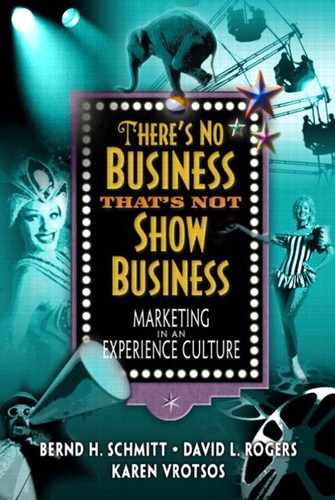Foreword
Smart companies today realize that traditional forms of marketing and communications don't cut it any more. Customers want more than a smiling face accompanied by a catchy slogan and jingle aired on prime-time TV. Instead, customers judge products, brands, and entire organizations based on the experiences that they offer. Companies therefore need to provide experiences, and these experiences must be entertaining, engaging, boundary breaking, and at the same time value creating. Show business delivers such experiences, and in a more cost-effective way than any other form of marketing. As a result, there is no business that can't benefit from show business.
But what is the right type of show for your brand? How do you stage and manage a show? How do you instill show business into the organization as a whole?
This book shows you how by providing numerous examples of successful show business practices in today's organizations. As you will see, we found most cases outside the frame of traditional marketing and traditional media. Customers are getting quite skeptical and cynical about advertising and other traditional media. In response, many of the newest forms of marketing that we have found echo traditions that predate television. These new forms offer experiences instead of cut-and-dried messages: road shows, jamborees, product play shops, street theater, fairs, and other face-to-face encounters. That's why the old-fashioned term show business makes sense. The old razzle-dazzle experience mixed with up-to-the-minute technology is bringing marketing into the future.
By now, the uses of experience by businesses have multiplied beyond theater-like performances at theme parks and restaurants to include buzz marketing, product launches, customer retention, internal communications, and nontraditional advertising. We view these show business experiences as a branding tool and a part of your increasingly diversified marketing mix. These experiences are valuable because they are face-to-face, interactive, help you reach and focus on your most valuable customers, and are capable of creating real loyalty and genuine relationships. They are not just razzle-dazzle, Las Vegas style. They are strategic and value-creating.
Our take on the experience aspect of show business is related to two other books (as well as a series of articles) authored by one of us, Bernd Schmitt. Experiential Marketing, published in 1999, provided an integrated marketing approach that moves beyond the functional features and benefits of a product to differentiate a brand. Customer Experience Management, published in 2003, provided a five-step process for connecting with customers through unique brand experiences, customer interfaces, and innovations.
As a consultant and CEO of The EX Group, Schmitt has used these frameworks and tools with companies in consumer packaged goods, automobile, electronics, software, financial services, pharmaceuticals, beauty and cosmetics, hospitality, and media industries. In working with these clients and with David L. Rogers and Karen Vrotsos, it became clear that many companies needed not only long-term strategic initiatives to manage customer experiences, but also concepts and tools for how to use creative, fun experiences to engage their customers and their own employees. In this book you find such concepts and tools as well as numerous cases of successful show business projects.
In many successful companies show business is alive and kicking, a well-kept secret behind the corporate curtain. This book will open the curtain and let you see the value that show business can offer to your business.
Ladies a-a-a-n-n-n-d Gentlemen in Business! Let the show begin!
Bernd H. Schmitt, David L. Rogers, Karen Vrotsos
The EX Group, LLC <[email protected]>
New York City, May 2003
